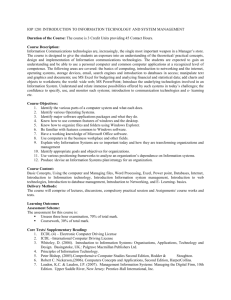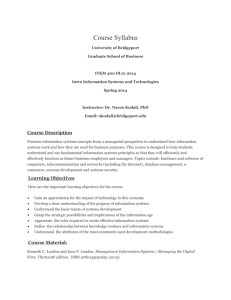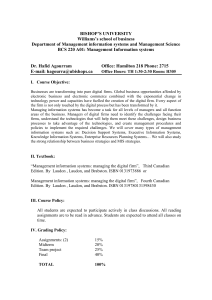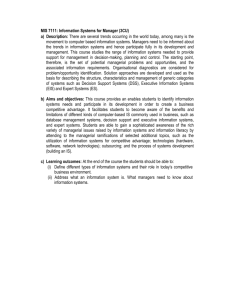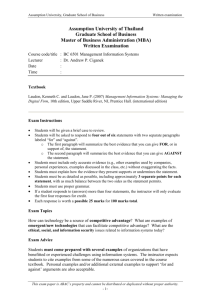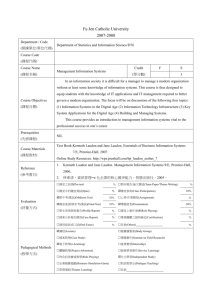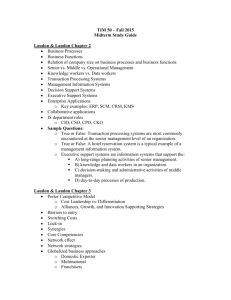Obtaining Business Value from Information Systems Lou Ann
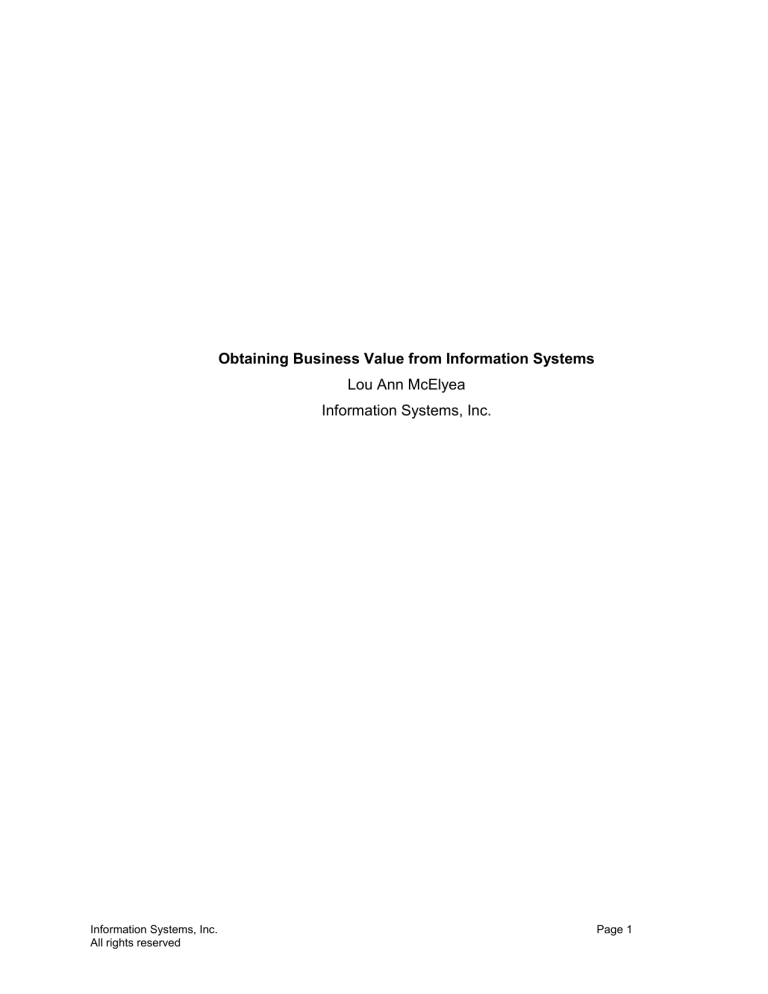
Obtaining Business Value from Information Systems
Lou Ann McElyea
Information Systems, Inc.
Information Systems, Inc.
All rights reserved
Page 1
Abstract
This paper addresses some key questions about the value of information systems to the business. The management challenges and factors to consider in building information systems today are addressed . The competitive advantage a “digital firm” has in the global business environment is explored.
Information Systems, Inc.
All rights reserved
Page 2
The Business Value of an Information System
“The value of an information system to a business is determined by the extent to which the system will lead to better management decisions, more efficient business processes and higher firm profitability (Laudon & Laudon, 2012).
” The culture of the firm has a significant impact on the degree of success of their information systems. Factors in the culture include values, formal as well as informal organizational structures and employee behaviors. The attitude senior management holds about the value of information systems has an impact as well. If senior management views information systems as an asset and an investment, as opposed to an expense, employees and customers will view information systems as having higher value.
Information systems may be implemented to support existing business processes or business processes may be redesigned in order to better utilize a new information system. To obtain value from the information system, there should be alignment of the business processes with the information system. Training is an aspect within the business environment that should not be overlooked to ensure value is realized from information systems.
In order to optimize the value of information systems, the culture needs to recognize the importance of efficiency and effectiveness. Oftentimes information systems are viewed as improving efficiency but improvement in effectiveness can have an even greater impact on profitability than just increasing efficiency alone. If customers are able to do business with the firm more effectively, the systems are viewed as adding value. Efficiency translates into cost savings while effectiveness translates into increased customer satisfaction. Information systems are part of value-adding activities for acquiring, transforming and distributing information that managers can use to improve decision making, enhance organizational performance and ultimately, increase firm profitability.
“Hallmarks of best practice organizations that deliver compelling value to their companies and customers through information systems are open dialogue, shared accountability and a willingness to change. Best practices suggest that a firm needs to
Information Systems, Inc.
All rights reserved
Page 3
define what value means to users of information technology for every project (Cortada,
1998).
”
Some examples of results that companies expect to achieve through efficient and effective use of information systems are:
Being nationally recognized as outstanding in customer service.
Delivering over 40 percent annual growth in a new service line.
Making the firm the acknowledged quality leader.
Nurturing high employee satisfaction.
Being the industry low-cost provider.
Being the industry high-value provider (Cortada, 1998).
These factors must be considered and actions taken to realize greater value from information systems.
Key Management Challenges
The key management challenges involved in building, operating and maintaining information systems today are the:
1. Information systems investment challenge for management is to know how their organization can determine the business value of systems.
2. Strategic business challenge for management is the ability to use information technology to design digitally-enabled organizations that are competitive and effective.
3. Globalization challenge for management is to understand the systems requirements of a global economic environment.
4. Information technology architecture and infrastructure challenge is to be able to help their organizations develop an information architecture that is able to support the company goals when both the business conditions and the technologies are changing so rapidly.
Information Systems, Inc.
All rights reserved
Page 4
5. Responsibility and control challenge is to understand how organizations can ensure that their information systems are used in an ethically and socially responsible way (Laudon & Laudon, 2012).
Overcoming these Challenges
Some of the ways in which management can overcome these challenges are:
1. Understand the business value of information systems. Treating information systems as a key corporate asset like money, physical assets and humans allows management to measure the value. For each major investment in information systems, a business plan should be developed that defines the return on investment. When money is invested in information systems, it is no longer available for investment in other assets for the business. Tracking results is important to assessing value. “Well run organizations usually measure value by linking measures to customer focus, a set of balanced criteria across service lines or functions, and continuous improvement (Cortada, 1998).
”
2. Ensure the complimentary assets needed to make the technology assets profitable, competitive and productive are in place. Fundamental changes in employee and management behavior, new business models, and elimination of inefficiencies of old business processes, work rules and organizational structures may be required.
3. Develop integrated multinational information systems. “Businesses must develop global hardware, software and communications standards. They must create cross-cultural accounting and reporting structures and design transnational business processes (Laudon & Laudon, 2012).
” Accounting and tax rules differ among different countries. Cultural issues influence business processes and as a result the supporting information systems. Requirements definition for global systems are considerably more complex than domestic systems and would best be developed by a global, cross-functional team.
4. Create an information technology infrastructure that incorporates compatible as well as incompatible hardware, software and communications
Information Systems, Inc.
All rights reserved
Page 5
networks. Establish standards for design, development and communications.
Systems not only must span the entire enterprise including global operations but they must accommodate business partners needing access to corporate information.
Enterprise systems address many of the challenges but are not always seamless and often take years and millions of dollars to implement. Hardware, software and telecommunications technology must be designed on a global scale. The Internet has eliminated many previous telecommunications issues.
5. Implement processes and controls to ensure that information systems are used in an ethical and socially responsible manner. “Management must make informed decisions and be sensitive to the human issues surrounding security and control of their information systems for employees, customers, suppliers and stockholders (Laudon & Laudon, 2012).
”
Digital Enterprises Leverage Information Systems
“A digital firm is one in which all major processes are digitally enabled. They manage their internal processes and relationships with customers, suppliers, employees, stockholders and external entities with technology. A digital firm relies heavily on information technology to enable, mediate, and streamline its internal and external operations. As a result, the firm is more flexible, profitable, competitive, and efficient than a traditional firm (Laudon & Laudon, 2012).
” All major functions of the firm are supported by information technology: sales and marketing, manufacturing and production, finance and accounting, and human resources.
Some examples of digital companies are:
Wal-Mart has become the number one retailer in the world through the use of information systems. Their early implementation of supply chain management cemented their relationships with suppliers, drove product costs down, reduced inventories and reduced transportation costs. In recent years, their adoption of self-service checkout and RFID technology has reduced costs even further ( www.walmartstores.com
).
Information Systems, Inc.
All rights reserved
Page 6
Federal Express (FedEx) is a firm that was digitally enabled early in their history. FedEx was founded in 1971 and in 1979 Federal Express launched
COSMOS (Customers, Operations and Services Master Online System), a centralized computer system to manage people, packages, vehicles and weather scenarios in real time ( www.fedex.com
). Their use of information systems to allow customers access to shipping and tracking data reduced costs, improved customer satisfaction and gave them a competitive advantage.
Amazon.com and eBay are companies built upon Internet technology. All their business processes and relationships are digitally enabled. These companies do not make products but provide sales, marketing and billing services to other businesses and individuals through the use of information systems software, servers, databases and networks. More recently Amazon.com has launched cloud computing services to their customers at very attractive prices.
Obtaining value from information systems is critical to the profitability and long-term growth of the business. There are complex decisions that must be made to fully leverage information systems and technology for competitive advantage but only those companies who are able to successfully meet the challenge will remain viable in the future.
Page 7 Information Systems, Inc.
All rights reserved
References
Cortada, James W., (1998), Best Practices in Information Technology, Prentice Hall
PTR, Upper Saddle River, New Jersey
Electronic Product Codes (EPC), retrieved from http://walmartstores.com/GlobalWMStoresWeb/navigate.do?catg=331
History of FedEx Operating Companies, retrieved from http://about.van.fedex.com/fedex-opco-history
Laudon, Kenneth C. & Laudon, Jane P., (2012), Management Information Systems,
Managing the Digital Firm, Pearson, Prentice Hall, Upper Saddle River, New
Jersey
Information Systems, Inc.
All rights reserved
Page 8
